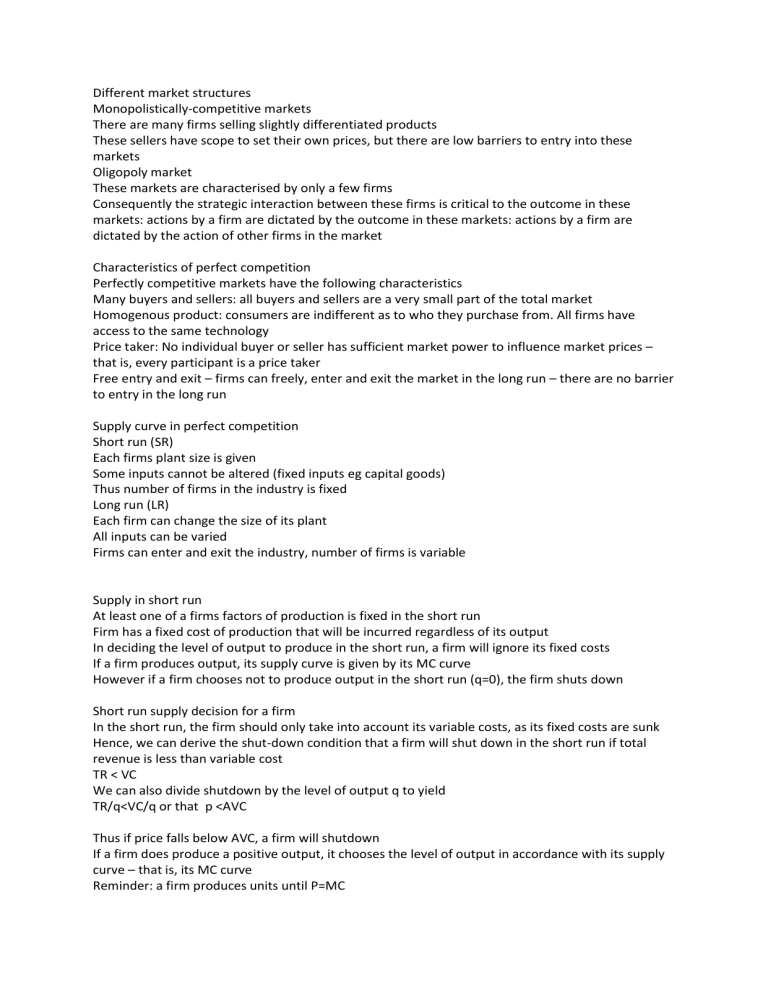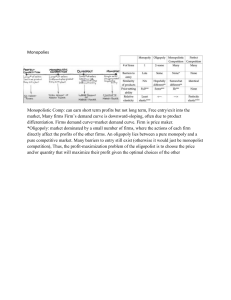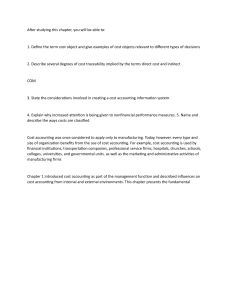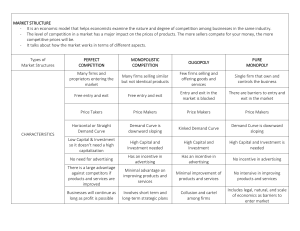
Different market structures Monopolistically-competitive markets There are many firms selling slightly differentiated products These sellers have scope to set their own prices, but there are low barriers to entry into these markets Oligopoly market These markets are characterised by only a few firms Consequently the strategic interaction between these firms is critical to the outcome in these markets: actions by a firm are dictated by the outcome in these markets: actions by a firm are dictated by the action of other firms in the market Characteristics of perfect competition Perfectly competitive markets have the following characteristics Many buyers and sellers: all buyers and sellers are a very small part of the total market Homogenous product: consumers are indifferent as to who they purchase from. All firms have access to the same technology Price taker: No individual buyer or seller has sufficient market power to influence market prices – that is, every participant is a price taker Free entry and exit – firms can freely, enter and exit the market in the long run – there are no barrier to entry in the long run Supply curve in perfect competition Short run (SR) Each firms plant size is given Some inputs cannot be altered (fixed inputs eg capital goods) Thus number of firms in the industry is fixed Long run (LR) Each firm can change the size of its plant All inputs can be varied Firms can enter and exit the industry, number of firms is variable Supply in short run At least one of a firms factors of production is fixed in the short run Firm has a fixed cost of production that will be incurred regardless of its output In deciding the level of output to produce in the short run, a firm will ignore its fixed costs If a firm produces output, its supply curve is given by its MC curve However if a firm chooses not to produce output in the short run (q=0), the firm shuts down Short run supply decision for a firm In the short run, the firm should only take into account its variable costs, as its fixed costs are sunk Hence, we can derive the shut-down condition that a firm will shut down in the short run if total revenue is less than variable cost TR < VC We can also divide shutdown by the level of output q to yield TR/q<VC/q or that p <AVC Thus if price falls below AVC, a firm will shutdown If a firm does produce a positive output, it chooses the level of output in accordance with its supply curve – that is, its MC curve Reminder: a firm produces units until P=MC Remember that the MC curve intersects the AVC curve at its minimum Hence shutdown rule for a competitive firm is p<AVC min On the other hand, a firm will supply a positive quantity provided: p>AVC min Hence a firms short run supply curve is its MC curve that lies above AVC min Market supply in the short run Short run there is no entry or exit of firms in the competitive market A firm is precented from exiting the market by its fixed costs If a firm in the market wishes not to produce anything, it shuts down (but does not exist) No new firms can enter in the short run Hence the number of firms in the market is fixed in the short run Short run market supply results from horizontal summation of the individual firms supply curves Profit and losses in the short run In a competitive market, it is possible for firms to make profit, break-even or incur in the short run If a firm is making a loss, total revenue must be less than total costs In other words, it must be that p<ATC Conversely, if a firm is making profits: TR>TC or P>ATC Difference between P and ATC at the quantity supplied is the average profit (or loss) a firm is making A firm will be willing to continue to sell in the short run when making a loss provided P>AVC min Firm is better off than shutting down because the extra revenue (in excess of its variable costs) help it pay for some of its fixed costs A firm in a perfectly competitive market, making a profit (P>ATC). The grey area represents size of profit in short run A firm in a perfectly competitive market making a loss (P<ATC). The grey area represents the size of the loss Supply in the Long run Long run: all production factors are variable Firms can exit a market/ industry, new firms can start operating in a market In the long run, there is free entry and exit of firms in the market This means that all costs are opportunity costs (no sunk costs) Hence a firm deciding its level of output in the long run will take into account the cost of all inputs A firm will enter or exit the market depending on its (anticipated) level profit or loss in the market Market will reach its long run equilibrium when there is no longer any entry into or exit from the market – this occurs when firms are making zero (economic) profits Firm supply: the exit/ entry decision With free entry and exit in the long run, if a firm chooses to exit it incurs no costs (unlike the FC incurred in the short run) Hence a firm will choose to exit the market if its total revenue is less than its total costs Menas firm will exit if P<ATCmin Hence a firms long run supply curve is the section of its long run MC that lies above (LR)ATCmin Elimination of profits and losses In LR, firms can enter or exit depending on whether they are going to make a profit or loss When firms in the market are profitable (P>ATC min) firms will want to enter the market Entry of more firms into the market will shift the SR market supply curve to the right, driving the equilibrium price down When firms in the market are sustaining losses firms will exit the market Shifts the SR supply curve left pushing the equilibrium price up as firms leave Long run equilibrium Because of free exit and entry of firms Price tends to decrease when it is above ATC and increase when it is below ATC Hence price = ATC in LR Because the firm supply curve cuts the ATC at min, the LR market price will = ATCmin As price equals ATC, a competitive firm will make 0 profit in LR Because there are 0 profits there is no incentive for any further exit or entry Market supply in LR For LR market supply curve we need to account for the fact that market responds to demand via the entry and exit of firms In LR price always adjusts back to min of AVC Hence taking account of exit/ entry, LR industry supply curve is horizontal at ATCmin An industry with a perfectly elastic LR supply curve is a constant cost industry Unless stated, a competitive industry is assumed to be a constant cost industry If there is an increase in demand in the short run, price rises and firms in the industry increase output and make economic profit. However in the long run new entrants will force price down to LR ATCmin Increasing cost industry In a constant cost industry entry and exit in the long run ensures all firms earn 0 profit and price is P=ATCmin This assumes all firms have access to same technology and same cost structure, further this cost structure does not change as the industry grows LR industry supply curve does not need to be perfectly elastic LR supply curve can instead be upward sloping, increasing cost industry If entrants have higher costs that established firms Some resources used in production may have limited supply (input prices rise as industry expands) thus costs for all firms rise Congestion may rise with industry output (eg airlines) Decreasing cost industry Suppose as output in an industry expands, costs for all firms fall If there is economies of scale in input markets Eg computer software industry, as market expands costs fall If this is the case, following an increase in demand, entry will continue until it is no longer profitable, the new LR equilibrium price has to be lower than the initial equilibrium price In this case, LR industry supply curve is down sloping, decreasing cost industry






